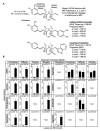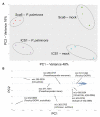Clovamide, a Hydroxycinnamic Acid Amide, Is a Resistance Factor Against Phytophthora spp. in Theobroma cacao
- PMID: 33424909
- PMCID: PMC7786005
- DOI: 10.3389/fpls.2020.617520
Clovamide, a Hydroxycinnamic Acid Amide, Is a Resistance Factor Against Phytophthora spp. in Theobroma cacao
Abstract
The hydroxycinnamic acid amides (HCAAs) are a diverse group of plant-specialized phenylpropanoid metabolites distributed widely in the plant kingdom and are known to be involved in tolerance to abiotic and biotic stress. The HCAA clovamide is reported in a small number of distantly related species. To explore the contribution of specialized metabolites to disease resistance in cacao (Theobroma cacao L., chocolate tree), we performed untargeted metabolomics using liquid chromatography - tandem mass spectrometry (LC-MS/MS) and compared the basal metabolite profiles in leaves of two cacao genotypes with contrasting levels of susceptibility to Phytophthora spp. Leaves of the tolerant genotype 'Scavina 6' ('Sca6') were found to accumulate dramatically higher levels of clovamide and several other HCAAs compared to the susceptible 'Imperial College Selection 1' ('ICS1'). Clovamide was the most abundant metabolite in 'Sca6' leaf extracts based on MS signal, and was up to 58-fold higher in 'Sca6' than in 'ICS1'. In vitro assays demonstrated that clovamide inhibits growth of three pathogens of cacao in the genus Phytophthora, is a substrate for cacao polyphenol oxidase, and is a contributor to enzymatic browning. Furthermore, clovamide inhibited proteinase and pectinase in vitro, activities associated with defense in plant-pathogen interactions. Fruit epidermal peels from both genotypes contained substantial amounts of clovamide, but two sulfated HCAAs were present at high abundance exclusively in 'Sca6' suggesting a potential functional role of these compounds. The potential to breed cacao with increased HCAAs for improved agricultural performance is discussed.
Keywords: Phytophthora; Theobroma cacao; black pod rot; clovamide; hydroxycinnamic acid amide; metabolomics; oomycete; polyphenol oxidase.
Copyright © 2020 Knollenberg, Li, Lambert, Maximova and Guiltinan.
Conflict of interest statement
The authors declare that the research was conducted in the absence of any commercial or financial relationships that could be construed as a potential conflict of interest.
Figures








Similar articles
-
Two Theobroma cacao genotypes with contrasting pathogen tolerance show aberrant transcriptional and ROS responses after salicylic acid treatment.J Exp Bot. 2015 Oct;66(20):6245-58. doi: 10.1093/jxb/erv334. Epub 2015 Jul 10. J Exp Bot. 2015. PMID: 26163705 Free PMC article.
-
Changes in Gene Expression in Leaves of Cacao Genotypes Resistant and Susceptible to Phytophthora palmivora Infection.Front Plant Sci. 2022 Feb 8;12:780805. doi: 10.3389/fpls.2021.780805. eCollection 2021. Front Plant Sci. 2022. PMID: 35211126 Free PMC article.
-
Cacao pod transcriptome profiling of seven genotypes identifies features associated with post-penetration resistance to Phytophthora palmivora.Sci Rep. 2024 Feb 20;14(1):4175. doi: 10.1038/s41598-024-54355-8. Sci Rep. 2024. PMID: 38378988 Free PMC article.
-
Clovamide and Its Derivatives-Bioactive Components of Theobroma cacao and Other Plants in the Context of Human Health.Foods. 2024 Apr 6;13(7):1118. doi: 10.3390/foods13071118. Foods. 2024. PMID: 38611422 Free PMC article. Review.
-
Hydroxycinnamic acid amides in rice: biosynthesis, distribution, function, and implication for crop development.Front Plant Sci. 2025 May 29;16:1525268. doi: 10.3389/fpls.2025.1525268. eCollection 2025. Front Plant Sci. 2025. PMID: 40510177 Free PMC article. Review.
Cited by
-
Red Clover HDT, a BAHD Hydroxycinnamoyl-Coenzyme A:L-3,4-Dihydroxyphenylalanine (L-DOPA) Hydroxycinnamoyl Transferase That Synthesizes Clovamide and Other N-Hydroxycinnamoyl-Aromatic Amino Acid Amides.Front Plant Sci. 2021 Nov 9;12:727461. doi: 10.3389/fpls.2021.727461. eCollection 2021. Front Plant Sci. 2021. PMID: 34868112 Free PMC article.
-
Interactions of Different Species of Phytophthora with Cacao Induce Genetic, Biochemical, and Morphological Plant Alterations.Microorganisms. 2023 Apr 29;11(5):1172. doi: 10.3390/microorganisms11051172. Microorganisms. 2023. PMID: 37317146 Free PMC article. Review.
-
Secondary Metabolites in Nectar-Mediated Plant-Pollinator Relationships.Plants (Basel). 2023 Jan 25;12(3):550. doi: 10.3390/plants12030550. Plants (Basel). 2023. PMID: 36771634 Free PMC article. Review.
-
The Role of Hydroxycinnamic Acid Amide Pathway in Plant Immunity.Front Plant Sci. 2022 Jun 22;13:922119. doi: 10.3389/fpls.2022.922119. eCollection 2022. Front Plant Sci. 2022. PMID: 35812905 Free PMC article. Review.
-
Impact of Polyvinylpyrrolidone-Vinyl Acetate Copolymer and Sodium Starch Glycolate Excipients on Phenolic Extraction from Red Clover: Enhancing Biological Activity and Antioxidant Potential.Pharmaceutics. 2024 Mar 14;16(3):399. doi: 10.3390/pharmaceutics16030399. Pharmaceutics. 2024. PMID: 38543293 Free PMC article.
References
-
- Akaza J. M., Kouassi A. B., Akaffou D. S., Fouet O., N’Guetta A. S. -P., Lanaud C. (2016). Mapping QTLs for black pod (Phytophthora palmivora) resistance in three hybrid progenies of cocoa (Theobroma cacao L.) using SSR markers. Int. J. Sci. Res. Publ. 6, 298–311.
-
- Akaza M. J., N’Goran J. A. K., N’Guetta S. P. A., Kébé B. I., Tahi G. M., Sangaré A. (2009). Resistance to Phytophthora palmivora (Butler) Butler assessed on leaf discs of cacao (Theobroma cacao L.) hybrid trees. Asian J. Plant Pathol. 3, 106–118. 10.3923/ajppaj.2009.106.118 - DOI
-
- Ali S. S., Shao J., Lary D. J., Kronmiller B. A., Shen D., Strem M. D., et al. . (2017). Phytophthora megakarya and Phytophthora palmivora, closely related causal agents of cacao black pod rot, underwent increases in genome sizes and gene numbers by different mechanisms. Genome Biol. Evol. 9, 536–557. 10.1093/gbe/evx021, PMID: - DOI - PMC - PubMed
-
- Alonso-Salces R. M., Guillou C., Berrueta L. A. (2009). Liquid chromatography coupled with ultraviolet absorbance detection, electrospray ionization, collision-induced dissociation and tandem mass spectrometry on a triple quadrupole for the on-line characterization of polyphenols and methylxanthines in green coffee beans. Rapid Commun. Mass Spectrom. 23, 363–383. 10.1002/rcm.3884, PMID: - DOI - PubMed
LinkOut - more resources
Full Text Sources
Other Literature Sources
Miscellaneous

